Product Images Donepezil Hydrochloride
View Photos of Packaging, Labels & Appearance
Product Label Images
The following 18 images provide visual information about the product associated with Donepezil Hydrochloride NDC 59746-330 by Jubilant Cadista Pharmaceuticals Inc., such as packaging, labeling, and the appearance of the drug itself. This resource could be helpful for medical professionals, pharmacists, and patients seeking to verify medication information and ensure they have the correct product.
10mgbottle

This text is about a medication named Donepezi Hydrochloride USP 10 mg which comes in a firm-coated tablet. It includes information on dosage, usage, safety precautions, storage, and manufacturing details. The medication is dispensed by Jubilant Cadista Pharmaceuticals Inc in Salisbuy, USA, and the NDC is 59746-330-30. The text provides contact information for Jubilart Generics Ltd who produced it in Rookee, India. Additionally, it contains a pharmacist's note to dispense the patient information sheet.*
10mgcarton
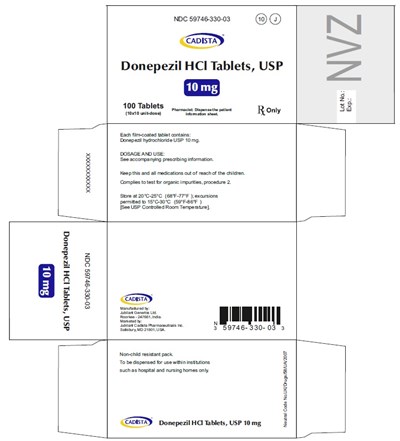
This appears to be a product description for a medication called Donepezil HCI Tablets, USP 10mg. It includes information about dosage and usage, storage requirements, and a warning about dispensing the medication only for use in specific facilities like hospitals or nursing homes.*
5mgbottle

This is a medication with NDC code 59746-329-30 that contains Donepezil Hydrochloride 5mg tablets, used for treating Alzheimer's disease. The dosage and usage details can be found in the accompanying prescription. It should be kept away from children and dispensed in a tight container. The tablets meet the test for organic impurities, procedure 2. The manufacturer is Jubilant Generics Ltd., Roorkee, India, and it is marketed in the USA by Jubiant Cadista Pharmaceuticals Inc. There is also a recommendation to store the medication at 20°C to 25°C, with permitted excursions to 15°C to 30°C.*
5mgcarton
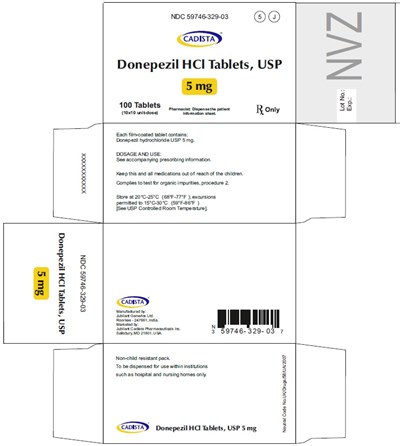
This document appears to be a label for a bottle of Donepezil HCI tablets, USP, with a dosage of 5mg and containing 100 tablets. The document includes instructions in regards to dosage and use, along with storage regulations and a warning to be dispensed only for use in specific institutions such as hospitals and nursing homes.*
fig01
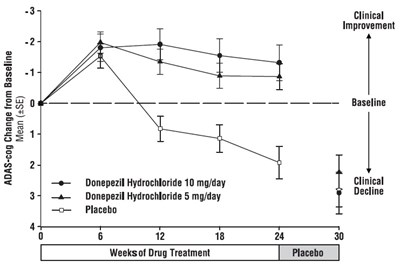
This appears to be a graph that shows the clinical improvement of a drug treatment over 24-30 weeks. It compares the effectiveness of Donepezil Hydrochloride at 5mg/day and 10mg/day to a placebo. The y-axis is labeled "Clinical Improvement" and the x-axis is labeled "Weeks of Drug Treatment". The graph shows that the 10mg/day dose had the most significant improvement, while the 5mg/day dose had a decline in improvement over time. The placebo had no significant improvement.*
fig02
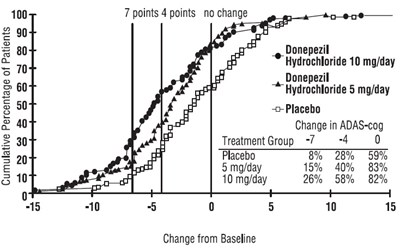
This appears to be a table with data related to a medical study involving different dosages of the drug Donepezil Hydrochloride as compared to a placebo for treating a condition measured by the ADAS-cog scale. The table shows the cumulative percentage of patients across different levels of improvement, with higher percentages indicating better outcomes. The treatment group includes those receiving either 5 or 10 mg/day of the drug, while the placebo group did not receive any active treatment. The change from baseline appears to indicate the level of improvement from the start of the study. Overall, this data suggests that both dosages of Donepezil Hydrochloride outperformed the placebo in improving the condition measured by ADAS-cog, with higher doses generally leading to greater levels of improvement.*
fig05
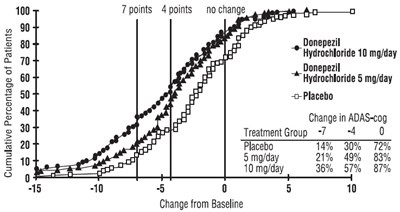
This text appears to be a table showing the results of a medical study on the effects of taking either Donepezil Hydrochloride at doses of 5mg/day or 10mg/day, or a placebo, on the cognitive functions of patients with Alzheimer's Disease. The table shows changes in a score called ADAS-cog, with negative numbers indicating improvement. The percentages indicate the proportion of patients who experienced those changes.*
fig07
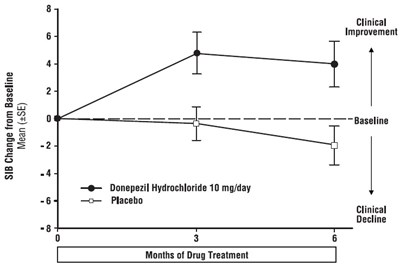
This text appears to be a graph displaying the clinical improvement or decline over a period of 6 months of drug treatment using Donepezil Hydrochloride 10 mg/day or a placebo. It is not possible to provide further information without additional context.*
fig09
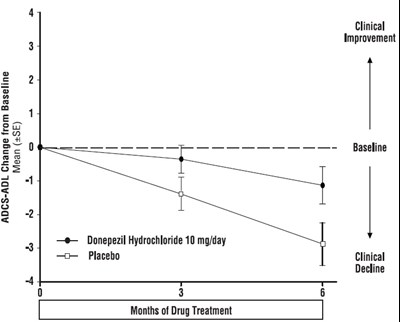
This is a graph showing the change in ADCS-ADL (Alzheimer's Disease Cooperative Study-Activities of Daily Living) score from baseline for patients taking 10mg/day of donepezil hydrochloride and those taking a placebo over a period of 6 months of drug treatment. The graph demonstrates a clinical improvement of 3-4 points for those taking donepezil hydrochloride, while those taking a placebo show a clinical decline of 2-4 points.*
fig10

The text is showing a graph or chart with cumulative percentage of patients, with data points for Donepezil Hydrochloride 10 mg/day and Placebo. There is also a line graph displaying the change in ADCS-ADL from Baseline, with data points at 10 and 15.*
fig11
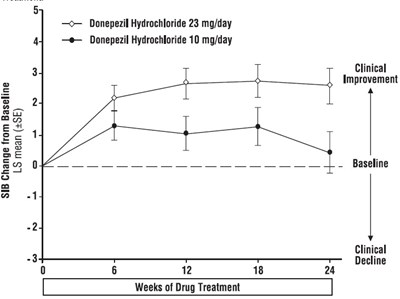
This is a graph showing the clinical improvement or decline of patients taking Donepezil Hydrochloride for 24 weeks at either 23 mg/day or 10 mg/day dosage.*
fig12
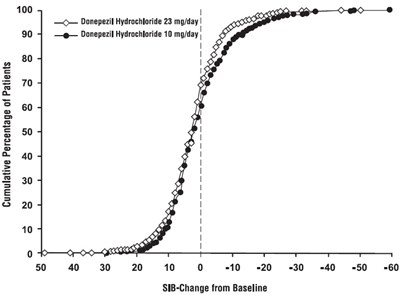
The text describes a graph showing the cumulative percentage of patients for Donepezil Hydrochloride 23 mg/day and 10 mg/day. The graph also shows the SIB change from baseline.*
fig13
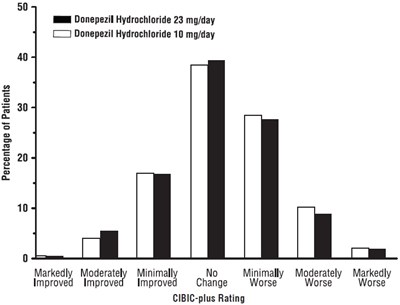
This is a table displaying the percentage of patients who experienced varying levels of improvement or worsening in their condition while taking differing doses of Donepezil Hydrochloride (either 23 mg/day or 10 mg/day). The outcomes are evaluated using the CIBIC-plus Rating scale, with the categories being "Markedly Improved," "Moderately Improved," "Minimally Improved," "No Change," "Minimally Worse," "Moderately Worse," and "Markedly Worse."*
* The product label images have been analyzed using a combination of traditional computing and machine learning techniques. It should be noted that the descriptions provided may not be entirely accurate as they are experimental in nature. Use the information in this page at your own discretion and risk.




